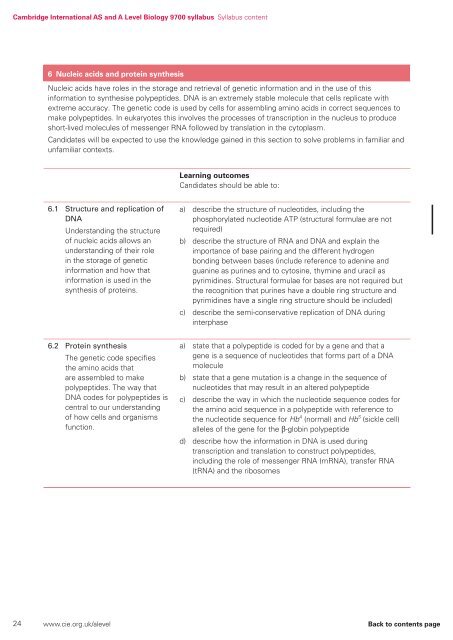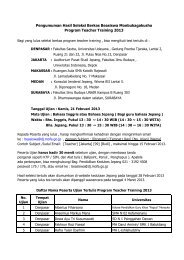9700_y16_sy
9700_y16_sy
9700_y16_sy
Create successful ePaper yourself
Turn your PDF publications into a flip-book with our unique Google optimized e-Paper software.
Cambridge International AS and A Level Biology <strong>9700</strong> <strong>sy</strong>llabus Syllabus content<br />
6 Nucleic acids and protein <strong>sy</strong>nthesis<br />
Nucleic acids have roles in the storage and retrieval of genetic information and in the use of this<br />
information to <strong>sy</strong>nthesise polypeptides. DNA is an extremely stable molecule that cells replicate with<br />
extreme accuracy. The genetic code is used by cells for assembling amino acids in correct sequences to<br />
make polypeptides. In eukaryotes this involves the processes of transcription in the nucleus to produce<br />
short-lived molecules of messenger RNA followed by translation in the cytoplasm.<br />
Candidates will be expected to use the knowledge gained in this section to solve problems in familiar and<br />
unfamiliar contexts.<br />
Learning outcomes<br />
Candidates should be able to:<br />
6.1 Structure and replication of<br />
DNA<br />
Understanding the structure<br />
of nucleic acids allows an<br />
understanding of their role<br />
in the storage of genetic<br />
information and how that<br />
information is used in the<br />
<strong>sy</strong>nthesis of proteins.<br />
a) describe the structure of nucleotides, including the<br />
phosphorylated nucleotide ATP (structural formulae are not<br />
required)<br />
b) describe the structure of RNA and DNA and explain the<br />
importance of base pairing and the different hydrogen<br />
bonding between bases (include reference to adenine and<br />
guanine as purines and to cytosine, thymine and uracil as<br />
pyrimidines. Structural formulae for bases are not required but<br />
the recognition that purines have a double ring structure and<br />
pyrimidines have a single ring structure should be included)<br />
c) describe the semi-conservative replication of DNA during<br />
interphase<br />
6.2 Protein <strong>sy</strong>nthesis<br />
The genetic code specifies<br />
the amino acids that<br />
are assembled to make<br />
polypeptides. The way that<br />
DNA codes for polypeptides is<br />
central to our understanding<br />
of how cells and organisms<br />
function.<br />
a) state that a polypeptide is coded for by a gene and that a<br />
gene is a sequence of nucleotides that forms part of a DNA<br />
molecule<br />
b) state that a gene mutation is a change in the sequence of<br />
nucleotides that may result in an altered polypeptide<br />
c) describe the way in which the nucleotide sequence codes for<br />
the amino acid sequence in a polypeptide with reference to<br />
the nucleotide sequence for Hb A (normal) and Hb S (sickle cell)<br />
alleles of the gene for the β-globin polypeptide<br />
d) describe how the information in DNA is used during<br />
transcription and translation to construct polypeptides,<br />
including the role of messenger RNA (mRNA), transfer RNA<br />
(tRNA) and the ribosomes<br />
24 www.cie.org.uk/alevel Back to contents page





